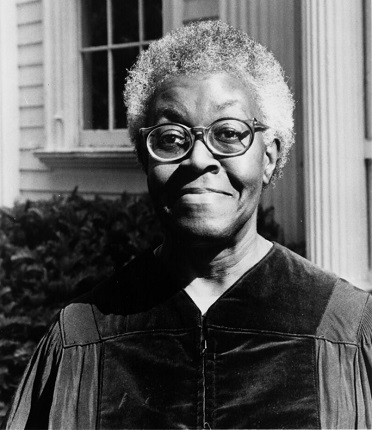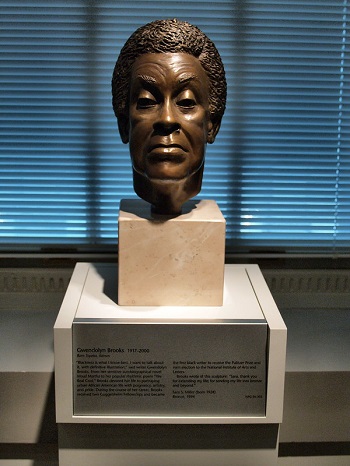
The poem “The Sonnet-Ballad” by Gwendolyn Brooks is a modern sonnet that incorporates some ballad elements. It presents the tragedy that war evokes not just on the actual battlefront but among those who remain at home. Through multiple poetic devices, which will be discussed in this essay, Brooks manages to convey an exceptionally piercing depiction of the devastating effects of war on those in the rear who had to separate from their loved ones in the front.
The poem is structured as an English/Shakespearean sonnet, consisting of 14 lines divided into three quatrains and one couplet. The meter pattern of the poem is iambic pentameter, which also fits the style of the sonnet. The rhyme scheme of the poem fairly resembles the classic rhyme pattern of the English sonnet, with several differences: ABAB-BCBC-DEDE-AA (instead of ABAB-CDCD-EFEF-GG).
The “B” rhyme in the first quatrain (ABAB) reiterates as well in the second quatrain (BCBC) rather than two different new rhymes (CDCD) that are supposed to appear in the traditional pattern of the English sonnet. That suggests a continuation of a similar sentiment in the second quatrain that resumes from the first. The “A” rhyme in the first quatrain (ABAB) also reiterates in the couplet (AA) in place of two entire new rhymes. That also conveys the sense of a related feeling all throughout the poem, instead of the rhythmic “turn” or “conclusion” that the classical couplet typically offers.
The level of diction in the poem is mainly medium and simple, with a few deviations of high diction words such as “lamenting,” “grandly” and “coquettish.” The speaker’s level of diction hints that she probably belongs to the middle class. It is also an indication that this particular social class carries most of the weight, and eventual loss, in wars.
The poem presents a narration of a story by a woman who tells how her lover left for war. That is what especially makes it also a ballad, as the title of the poem points out. In addition, there is a refrain in line 1 and in line 14, which is not conventional in sonnets; however, it is highly prevalent in ballads.
The three quatrains and the couplet of the sonnet lay out gradually and slowly the same story and notions, which characterize more the form of a ballad rather than a sonnet. In the first quatrain of the sonnet, the speaker essentially recounts the outline of her story: she bemoans that he left for war after she and her lover parted ways. In the second quatrain, the speaker acknowledges that her lover will not return to her ever again and that she perceives it as a sort of betrayal. In the third quatrain, the speaker elaborates that her lover’s betrayal materializes due to the allure of death in battle. In the couplet, the speaker despondently accepts that her lover will embrace death. Hence, there is no material “turn” in the sonnet, as there traditionally is, but a continuous portrayal of the speaker’s state of mind.

The poem’s speaker is a woman, which also shows that it is a modern sonnet, since in older times, mostly only men were the speakers in sonnets. In the refrain in lines 1 and 14, the speaker directly addresses her mother through an apostrophe: “Oh mother, mother.” The repetition of the word “mother” twice in each of the lines emphasizes the intense emotional state of the speaker. Even though lines 1 and 14 are exactly the same, it seems that the speaker’s tone is different in each one: Line 1 expresses wonderment and puzzlement, whereas line 14 carries the heaviness of despair and anguish. It is possible that the speaker does not even call out to her actual mother, but the apostrophe in the refrain is a symbolic call for safety and shelter that her mother represents in her mind. In this case, the speaker portrays her inner emotional suffering throughout the entire poem.
There are a few uses of imagery in the poem. In line 2, the speaker refers to her lover departing to war with a synecdoche – by his “tallness,” which describes his physical strength. In line 4, the speaker describes her sadness by a metaphor of her heart as an empty cup, an image that poignantly paints the feeling of emotional emptiness when parting from a loved one. In line 7, the speaker begins to depict the central metaphor of the poem that continues until line 13 – she portrays her lover’s departure for the army as an act of unfaithfulness, whereas death is personified as the “mistress.” This metaphor employs the topos of a romantic betrayal of a man with another woman. In lines 7-8, the speaker claims that she already realized her lover would be “untrue” when he walked out of the door “grandly,” which suggests that she perceives his proud departure as disloyalty to her.
In the third quatrain, the speaker fully develops the metaphor of death as a personification of a seductive woman whom her lover “courts.” In line 11, the word “arms” is a pun- possessive body parts or weapons of war. In line 13, the speaker depicts how her lover will not resist the temptation of battle and, consequently, will accept death.
There are six enjambments in the poem: In lines 3, 6, 7, 9, 10 and 11. This profusion of enjambments assists in characterizing the speaker. These frequent rhetorical gaps between lines create an effect of instability and even somewhat derangement, which connects with the poem’s overall ambiance of manic grief. The recurrence of the enjambments steadily increases from quatrain to quatrain: in the first quatrain, there is one enjambment; in the second quatrain, there are two enjambments; in the third quatrain, there are three enjambments. That builds the impression that the speaker gets more and more desperate and perhaps unbalanced as well.
To conclude, with “The Sonnet-Ballad,” Gwendolyn Brooks successfully intertwines the familiar form of the English sonnet with elements of the ballad. This modern poetic amalgamation generates a sharp, caustic impact on the readers, who can sympathize with the poem’s speaker, even if they have not shared the same dire experience themselves. The poem piercingly expresses the atrocities of war on those in the rear who lose their loved ones. Although the poem is pretty forthright and not very intricate compared to other sonnets or ballads, the poetic devices that Brooks utilizes to pass on its meaning produce a powerfully stinging impact on the reader.



